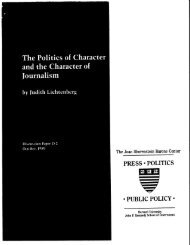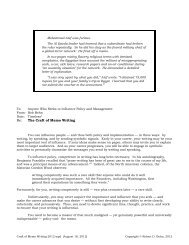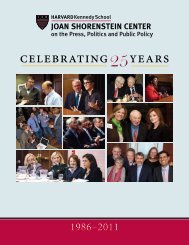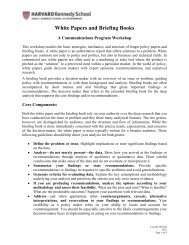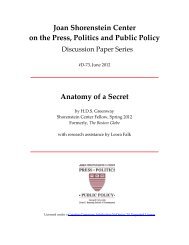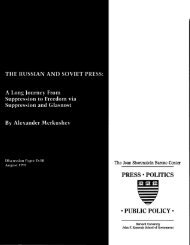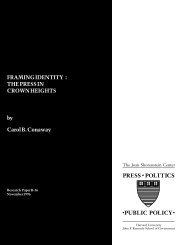Why Paper Is Eternal - Joan Shorenstein Center on the Press ...
Why Paper Is Eternal - Joan Shorenstein Center on the Press ...
Why Paper Is Eternal - Joan Shorenstein Center on the Press ...
Create successful ePaper yourself
Turn your PDF publications into a flip-book with our unique Google optimized e-Paper software.
Cai Lun introduced his innovati<strong>on</strong> to <strong>the</strong> court in 105 A.D and <strong>the</strong><br />
Chinese became <strong>the</strong> first great papermaking culture. But <strong>the</strong> new technology<br />
did not immediately race across <strong>the</strong> world and triumph over existing media. It<br />
spread slowly, first to Korea and Japan, <strong>the</strong>n west across Central Asia. In <strong>the</strong><br />
year 751 A.D., <strong>the</strong> Chinese lost a battle in Turkestan. Some of <strong>the</strong> Chinese<br />
soldiers who were taken pris<strong>on</strong>er knew how to make paper and turned over <strong>the</strong><br />
secret to <strong>the</strong>ir Turkish captors, and so<strong>on</strong> papermaking was underway in<br />
Samarkand. 40 From <strong>the</strong>re, <strong>the</strong> technology moved around <strong>the</strong> Middle East and<br />
finally, at some point around 1,000 A.D., it reached Western Europe. The<br />
oldest known example of Western paper is The Missal of Silos, a church<br />
manuscript from <strong>the</strong> eleventh century preserved in a Benedictine abbey in<br />
central Spain. 41<br />
When paper arrived in a given society, ra<strong>the</strong>r than wiping out <strong>the</strong><br />
existing communicati<strong>on</strong>s media – which were, principally, papyrus and<br />
parchment – it moved in beside <strong>the</strong>m. It was accepted and embraced to varying<br />
degrees, and over different stretches of time, depending <strong>on</strong> social, cultural and<br />
political circumstances. In Egypt, for instance, it appears that paper was quickly<br />
recognized as an improvement over <strong>the</strong> relatively inflexible and less durable<br />
papyrus (a paper-like writing material made from <strong>the</strong> stalk of <strong>the</strong> papyrus plant,<br />
from which paper takes its name). An Egyptian thank-you letter written around<br />
890 A.D closes with <strong>the</strong> phrase, “Pard<strong>on</strong> <strong>the</strong> papyrus.” Since <strong>the</strong> note appears<br />
<strong>on</strong> higher quality papyrus, historians have assumed that <strong>the</strong> writer was<br />
apologizing for not using paper. 42 By <strong>the</strong> eleventh century, Egyptian demand<br />
for paper was so great that “mummies were being disinterred for supplies of<br />
cloth for paper-making.” In Baghdad in <strong>the</strong> year 1226, <strong>the</strong>re were more than<br />
<strong>on</strong>e hundred papermakers and booksellers operating <strong>on</strong> a single street. 43<br />
21



